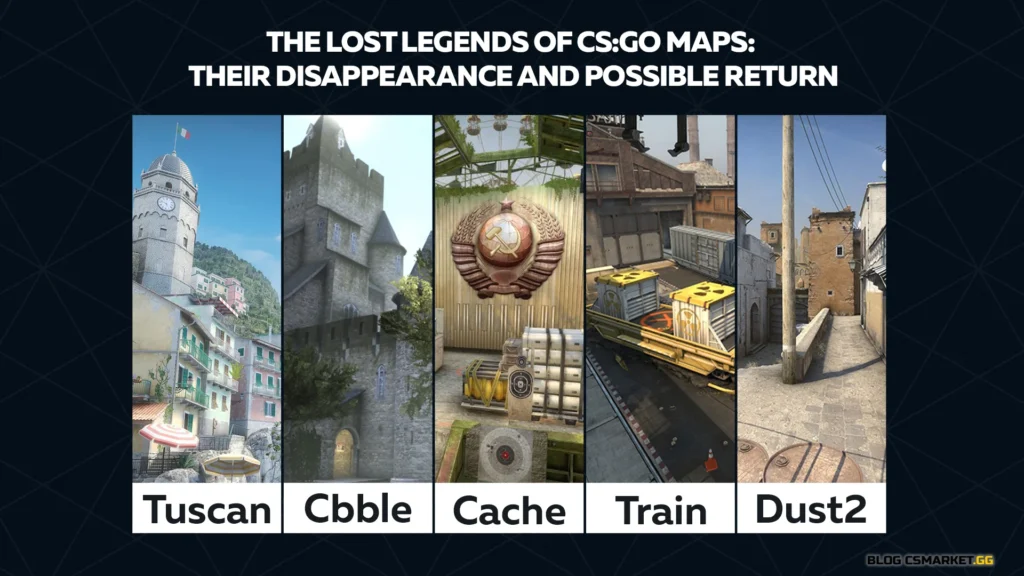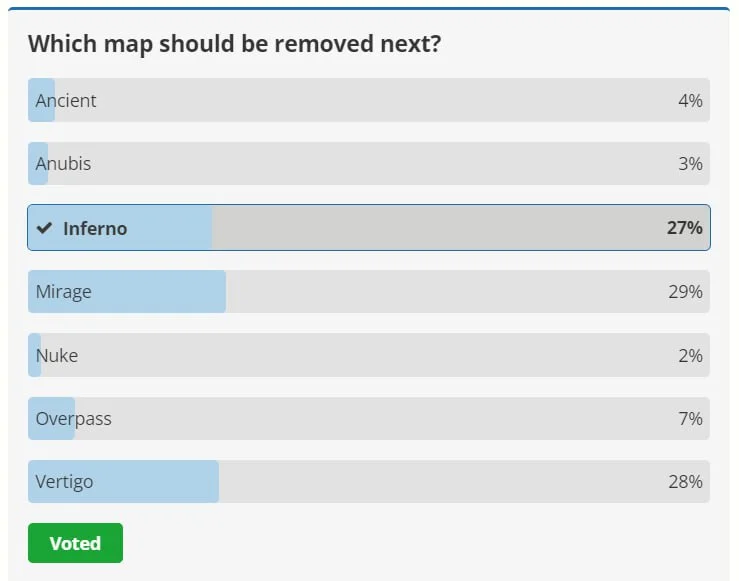CS:GO Maps: Disappeared Legends and Possible Returns

The professional CS scene revolves around 7 maps that form the competitive map pool and are used in tournaments. With the transition to CS2, many expected developers to make changes in this aspect of the game. This could have been an increase in the number of maps to nine or simply swapping one map for another. However, there have been no changes, and there won’t be until March 2024. The first Major for CS2 will be played on the same map pool as the last Major in CS:GO.
Many players anticipate such changes and eagerly await the return of some legendary maps to the competitive scene. The maps featured in today’s overview have given the world countless highlights and epic moments that have stayed in memory for years. Some maps were removed fairly recently, while others haven’t been seen in the pro scene for over 12 years!
Tuscan
A true classic of Counter-Strike 1.6. It was believed that this map showcased true skill and tactical genius of players. Disappointment struck all fans after transitioning to the CS:GO version due to numerous bugs. The main reason for abandoning this map in the competitive scene was the introduction of the Molotov cocktail into the game. The large number of dead-end spots simply made it unplayable and unbalanced. Tuscan always remained in the community’s memory, and every ace in pistol rounds reminded everyone of the legendary highlight by Edward from NAVI.
In August 2022, CS:GO celebrated its first anniversary. In honor of this event, VALVE released a major update. The main gift to the community was the long-awaited addition of Tuscan to the game. However, over two years have passed, and the map has not been added to the competitive map pool or transferred to CS2. According to recent rumors, files with the same name were discovered in the current version. So, we await the swift comeback of the CS 1.6 icon!
Cobblestone
The most beloved map at CS:GO Majors was removed in April 2018. At that time, linking your Steam account to Major streams would grant souvenir packages. From the Cobblestone collection, you could get the most expensive item in the game – the AWP Dragon Lore. However, not only the map but also the drop system was later changed. The map was remembered not only for its expensive souvenir collection but also for curious moments during professional matches. In one official match, legendary NAVI captain Zeus underestimated the damage from an incendiary grenade and burned out in the decisive round.
Despite its popularity, the map had to be removed. There were enough reasons for this. Its huge size and poor balance between defense and offense needed reworking. The map has been absent from the game for over 5 years, and there are no hints of its return.
Cache
If you played CS:GO during the peak of this map’s popularity, you know how often it was played in public matches. A large number of open duels, small size, and gameplay dynamics attracted many players. And who hasn’t tried to replicate s1mple’s two no-scopes on the B site?
Even the developers couldn’t pass by this moment and left a memorable graffiti. They also couldn’t come to terms with the fact that the rights to Cache belong not to VALVE but to a third-party developer from the community. As the map creator claims, it is not profitable for companies to have someone else’s product in the competitive mode. They want to have full control to be able to quickly respond to user reports and fix flaws. However, after 4 years, the developers still haven’t contacted the owner about buying the rights. There is a high probability that we will never see Cache on the professional scene again.
Train
If the tactical geniuses of CS 1.6 preferred to play Tuscan, then in CS:GO, Train became its successor. The addition of Molotov cocktails and incendiary grenades to the game only increased the balance between sides and opened up many new strategies. Every match on this map was interesting and made you view the game as a tactical shooter. All great championship teams had their win streak on Train, which allowed them to dominate the pro scene. Legendary highlights were also inevitable here.
Despite all the positives, the map was unpopular among casual users. Only experienced players could show confident performance, which wasn’t liked by newcomers. Young professional teams also ignored this map and preferred to ban it, especially against old-school players. Because of this fact, by mid-2021, this map was not played in 70% of matches, and the developers decided to remove it from the map pool, replacing it with the fresh Ancient.
Dust 2
Even if you’re not a seasoned Counter-Strike player, but you’ve at least logged into the game once, you’ve definitely played on this map. Without exaggeration, it’s the most popular map in every part of the franchise. Each player threw a flashbang over the top to long and resorted to the tactic “All rush B”. If you don’t have a highlight on Dust 2, then there’s no certainty that you’ve played this game at all.
Beautiful moments, understandable structure, recognizable appearance. This map simply has no weak spots, as absolutely everyone knows how to play Dust 2. Most likely, it’s for this reason that in the last Major at IEM RIO 2022, it was played in only 8 matches. Considering these facts, VALVE decided to remove it from tournaments and add Anubis, which is very similar in colors, structure, and desert motifs. However, they simply couldn’t completely remove it from the game, so we can still log into the game and see the Counter-Strike classic.
Certainly, many would like to see any of these maps return to the pro scene soon. But when that will happen remains to be seen. Perhaps after the PGL CS2 Major Copenhagen 2024, there will be changes in the competitive map pool. But will it be a legendary comeback or will VALVE roll out a new product? Quite recently, HLTV conducted a poll, and judging by its results, the main contenders for replacement are Mirage, Inferno, and Vertigo.
